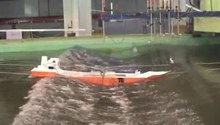Swell
As waves (also swell ) are water waves referred incurred in the oceans by wind.
A distinction is made between the wind sea currently generated by the wind and the swell that persists after the wind has subsided or comes from another location . Where the water depth falls below a certain level, the higher and steeper ground lake (plunge lake) forms.
Manifestations
The part of the swell that is under the direct influence of the generating wind field is called the wind sea . The wind sea is characterized by sharp wave peaks (compared to the wave valley). The so-called water waves are generated under the direct influence of local winds on the water surface. In contrast to the swell , it is characterized by an irregular structure and - in relation to the wavelength - high amplitude . The totality of all waves from swell and wind sea is called swell. Depending on the wind strength, one can also speak of a storm sea.
When the wind dies down, the waves of the wind sea slowly ebb away. The wave components with a long wavelength continue into areas where no (or another) wind blows. These residual waves are called swell and are flatter and have a rounded shape. If two wave systems from different directions meet, a cross sea results .
So far, the formation of monster waves has only been insufficiently researched .
Tidal waves are caused by the tide , but are generally only noticeable in narrow bays and estuaries . A well-known, relatively high tidal wave is the Pororoca in the Amazon . Like tsunamis triggered by seaquakes , tidal waves are not part of the swell.
Wave height
The wave height is defined as the vertical distance between the wave trough and the wave crest and results from the factors:
- Strength of the wind
- Duration of the wind
- Start-up section of the wind over water (effective length, fetch )
For all three factors it applies that the wave height increases strongly at the beginning, only to slowly approach a saturation value. One speaks of a “mature wind sea”. You can find weak swell when there is little wind, when the wind has just freshened up and on the Lee coast (which is turned away from the wind). You can find strong swell in strong winds that have been blowing on the windward coast for days.
The wavelength (the distance from wave crest to wave crest) results from the time interval between two wave crests (wave period T ):
The speed of propagation of water waves increases with wavelength. For example, a wave with L = 100 m moves at 45 km / h, one with L = 200 m moves at 63 km / h. Swell waves can wander through larger sea areas in a short time and thus serve as a messenger for the approaching wind.
Waves can be up to 30 meters high on the open sea, the wavelengths can reach up to 1000 meters. The steepness of a wave is also important: a low but steep wave with a short wave distance (wave length) can be very uncomfortable; a much higher but flat wave with a large wave spacing can be very gentle.
The characteristic surf waves arise in shallow water.
Swell scale

In correspondence to the wind force according to Beaufort referred to swell a unit in the maritime field.
According to the German captain Peter Petersen , the sea state scale includes strengths from 0 to 9. It was only published in 1927. It has been internationally recognized since 1939 and introduced by the World Meteorological Organization .
| Strength | lake | waves | Wind force |
|---|---|---|---|
| 0 | smooth | no | 0 |
| 1 | calm | ruffled | 1 |
| 2 | weakly moved | short | 2/3 |
| 3 | easily moved | small, foam heads | 4th |
| 4th | moderately agitated | long, foam heads, breaking | 5 |
| 5 | rough sea | large, foam combs form larger foam areas | 6th |
| 6th | very rough sea | breaking | 7th |
| 7th | high seas | Crests of waves, spray, strips of foam, rolling | 8th |
| 8th | very high seas | Crests of waves with long crests, the lake white with foam | 9 |
| 9 | exceptionally difficult | Crests of waves, ships disappear in troughs, the lake is white with foam | 10/11/12 |
See also
literature
- Franz Graf von Larisch-Moennich: Storm lake and surf . Published by Velhagen & Klasing, Bielefeld and Leipzig 1925.
- Andreas Malcherek: Tides and waves - The hydromechanics of the coastal waters . 1st edition. Vieweg + Teubner, Wiesbaden 2010, ISBN 978-3-8348-0787-8
Web links
- Current swell North and Baltic Sea (BSH)
- Sea state measurement with marine X-band radar (Helmholtz-Zentrum Geesthacht, Institute for Coastal Research, Radar Hydrography Department)
- Sea state measurement system based on X-band radar (OceanWaves GmbH)
Individual evidence
- ↑ a b https://www.spektrum.de/lexikon/geowwissenschaften/seegang/14669 Spektrum.de: Lexicon of Geosciences on Seegang, accessed on January 10, 2020
- ↑ Portal of the People's Navy: The Beaufort and Petersen scale, relationships between wind and waves . September 1, 2013, accessed February 25, 2016.


